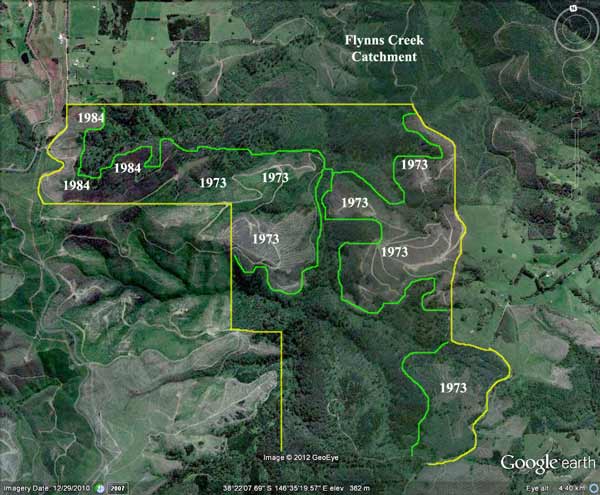

October 2010: Plantation and native forest in the Flynns Creek catchment, most of which was burnt in the February 2009 bushfires. Between 250-300ha of native forest remains in this plantation.
Numbers eg 76 refer to the year of plantation establishment. Most (approximately 200ha) appear to have occurred in 1973. It is highly likely that aerial application of 2,4,5-T @ 1.1 litres a hectare occurred. ~200ha in this plantation would have been aerially sprayed with 2,4,5-T in 1973. Totals used would have been 220 litres of 2,4,5-T with 10,000 litres of diesel.
Further spraying in 1984 with a concoction of Amitrole (Weedagol T.L. Plus) and (Gesaprim 500) Atrazine. In 2002 scientists in the United States found that Atrazine at levels as low of 0.1part per billion altered hormones in frogs. Since then Atrazine has been found to have the same effect across a range of animals. 30ha would probably have been sprayed with the Atrazine (4 l/ha/Amitrole 7l/ha) mixture. Totals 120 litres Atrazine, 210 litres Amitrole).
Perhaps 5-10 houses lie downstream of this plantation and may rely on Flynns Creek for drinking water.
Herbicides Used by Grand Ridge Plantations - Strzelecki Ranges and Gippsland Victoria
| Herbicide | Label Rate max as kg/ha | Used to control | Euc/Rad | Notes | Application |
| Clopyralid | 2.55 | Woody Weeds | Radiata and Eucalypts | Highly Toxic/Potential Ground water Contaminant | aerial or ground |
| Glufosinate Ammonium | 1 | Woody Weeds | Radiata | aerial or ground | |
| Glyphosate | 3.6 | Herbaceous and woody weeds, noxious weeds | Radiata, Eucalpts and Custodial | ||
| Haloxyfop-methyl | 0.13 | Annual and Pernneial Grasses | Eucalypts | Carcinogen | aerial or ground |
| Hexazinone | 4 | Woody Weeds | Radiata | Ground Water Contaminant | Aerial, ground, spot |
| Metsulfuron-Methyl | 0.06 | Woody Weeds, Noxious Weeds | Radiata, Eucalyptus and Custodial | Potential Ground Water Contaminant | Aerial, ground or spot |
| Sulfometuron Methyl | 0.6 | Annual and Perennial Grasses and broadleaf weeds | Eucalyptus | Potential Ground Water Contaminant | Aerial or Ground |
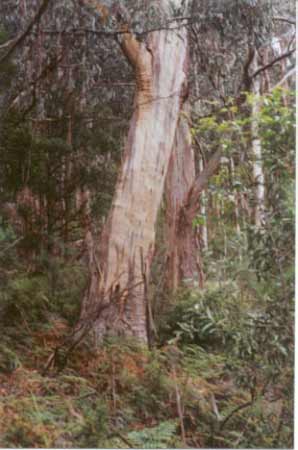
October 2001: Non plantation blue gum within plantation holding in Flynn Creek catchment - most likely burnt, but not killed in February 2009 bushfires..
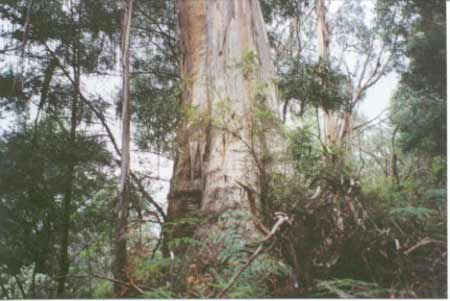
Soils according to 1978 Carrujung Geological Survey Map:
Tvo: Palaeocene/Eocene: Dense augite and olivine basalt, tuff, claystone and siltstone. Often extremely weathered and ferruginized.
Kls: Cretaceous (Lower Aptian) Paludal - Strzelecki Group: Feldspathic, lithic sandstone, siltstone and mudstone, minor black coal, quartzose sandstone, conglomerate, local carbonate concentrations. Abundant plant remains.
Hancock Watch Site visit October 01: This site consists of Radiata pine established in 1973 and 1984 on the southern half of the plantation. The area is located approximately 2.5-3km south of the village of Callignee and is located on quite steep slopes at least 4km north of the headwaters of Flynns Creek. 3 tributaries of Flynns Creek are also located in the plantation with Flynns Creek itself dissecting the plantation into two parts.
Entry into the plantation was made from Walker Track and then Stringer Track. About 500 metres down Stringer Track heading north east, young blue gums appeared on both sides of the track, with older trees located down the slopes and further along Stringer Track. The further down Stringer Track the more obvious it became that the trees were not plantation but regrowth and in some cases remnant old growth.
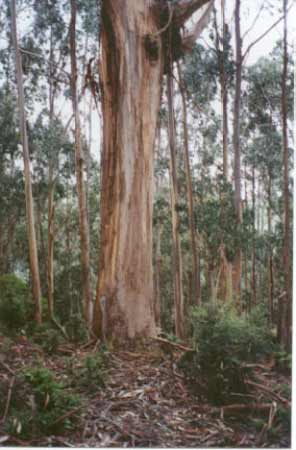
October 2001: Old growth and regenerating blue gum within plantation holding in Flynn Creek catchment.
From a gap in the trees it was obvious that a large amount of remnant vegetation was also apparent on the eastern side of Flynns Creek, including what appeared to be old growth. Access to this area did not occur on this visit. (it also appears that a large amount of native vegetation also occurs in the plantations south west, where it adjoins 93-107).
After leaving Stringer Track we headed west to the tributary of Flynns Creek. The topography here was steep with native vegetation to the right and a small crop of plantation pine to the left. It was apparent that native vegetation probably extended almost to the headwaters of the tributary and riprarian vegetation was also apparent at the site.

October 2001: Eastern side of Flynn Creek within plantation holding.
Hancock Watch site visit Nov 01: Tried entering this plantation from the south east (Callignee South Road) along a track called Island Track. Had no luck although a male koala was heard near where Island Track should have been (about 1km south of Flewin Track) in a place of little native vegetation, where 1973 pine plantations had recently been cleared.
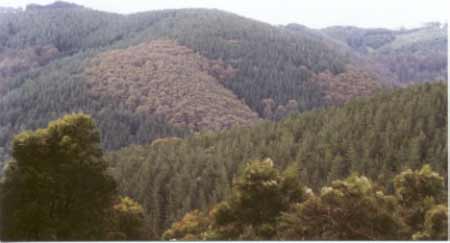
October 2001: Eastern side of Flynn Creek with native vegetation surrounded by radiata pine plantation.
Flynns Creek, Flynn: A small creek with some deep pools in its middle and upper reaches. Flows through open farmland, mud and gravel bottom. Occasionally stops running in summer, lower reaches are badly silted. Contains some brown trout average 250g, maximum 650g, eels, spiny freshwater crayfish, carp, goldfish and tupong.
Source: A Guide to the Inland Angling Waters of Victoria by BR Tunbridge, PL Rogan, CA Barnham. Department Conservation and Environment. Arthur Rylah Institute for Environmental Research, 123 Brown St, Heidelberg, 3084. (4th ed - 1991).